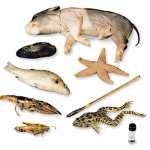Zoology
|
4 may 2015 01:48:12 |
| Wound care antiseptics - performance differences against Staphylococcus aureus in biofilm (Acta Veterinaria Scandinavica) |
|
Tweet Background:
Staphylococcus aureus is commonly isolated from infected wounds both in animals and humans. It is known to be an excellent biofilm former and biofilms are present in as many as 60% of chronic wounds. Despite that the presence of biofilms in infections are common, antiseptics are usually qualified for in vivo testing according to their effect on planktonic cells. As it is well known that bacteria in biofilms are more tolerant to antiseptics than planktonic bacteria, biofilm infections can be difficult to treat. The aim of the study was to compare three different categories of antiseptics, biguanide (chlorhexidine), quaternary ammonium compound (QAC; Pyrisept) and iodine/iodophores (2% iodine liniment), with regards to efficacy in killing S. aureus in biofilm. If there was observed a difference in efficacy between these antiseptics, a second aim was to find the most effective of the three antiseptics.
Results:
Large differences in the bactericidal effect of the different antiseptics against S. aureus in biofilm were observed in the present study. Iodine treatment was found to be the most effective followed by Pyrisept and chlorhexidine.
Conclusions:
The bactericidal effect of the different antiseptics used in the present study was found to vary significantly against S. aureus in biofilm. The present study gives valuable knowledge with regards to selecting the antiseptics that are most likely to be successful in treating biofilm infected wounds. This study also contributes to focus attention on the importance of qualifying antiseptics based on results using biofilm bacteria rather than planktonic bacteria. |
| 122 viewsCategory: Medicine, Zoology |
 Clinical and pharmacokinetic evaluation of S-ketamine for intravenous general anaesthesia in horses undergoing field castration (Acta Veterinaria Scandinavica) Clinical and pharmacokinetic evaluation of S-ketamine for intravenous general anaesthesia in horses undergoing field castration (Acta Veterinaria Scandinavica)Reactive oxygen species generation by bovine blood neutrophils with different CXCR1 (IL8RA) genotype following Interleukin-8 incubation (BMC Veterinary Research) 
|
| blog comments powered by Disqus |
MyJournals.org
The latest issues of all your favorite science journals on one page
The latest issues of all your favorite science journals on one page



